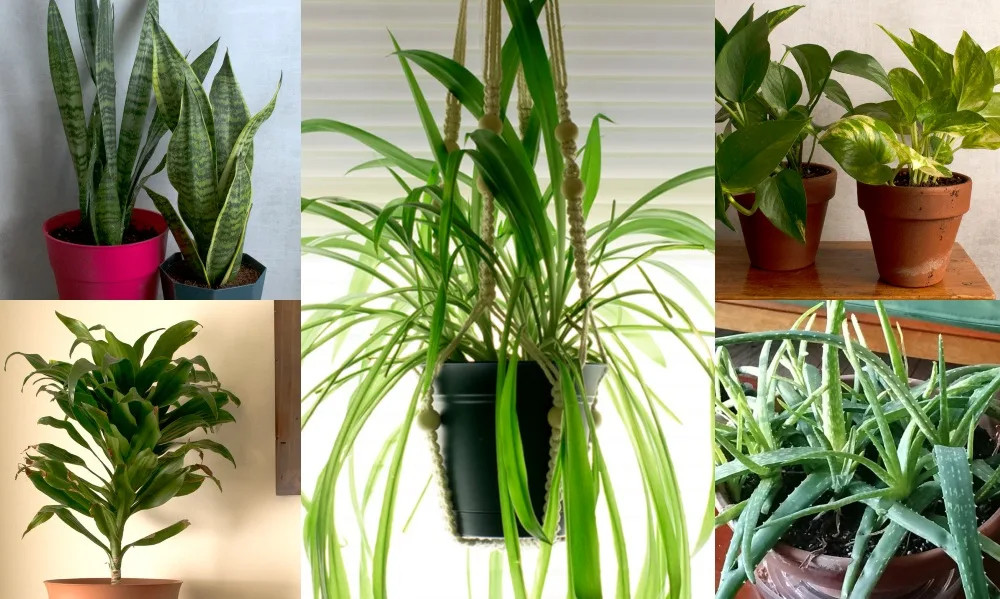
Houseplants do a lot to make a house a home. They clean the air we breathe, filtering out more than just CO2.
Houseplants improve our concentration and productivity and even brighten our moods.
Having plants in a room reduces noise and adds moisture to dry air.
Numerous scientific studies over the years have made it clear, bringing plants into your home is always a good idea.
Plus, they look nice.
But not everyone has the time or inclination to spend pampering fussy house plants.
Sometimes you just want something green in a room that doesn’t need to be fertilized every full moon, or have its leaves spritzed daily with freshly harvested dew.
Maybe you travel or hey, maybe you just forget to water your plants. (Raises hand.)
Before you go the route of purchasing a terrible looking fake plant, take a look at these easy to care for and hard to kill options.
Keeping any kind of houseplant means you’re going to have to water them at least occasionally and stick them somewhere with appropriate sunlight.
Yes, you can enjoy all the benefits of house plants without the high maintenance upkeep.
A lot of lists focus on particular plants that are easy to care for. But to make it onto my list, they also have to be hardy and bounce back. Because let’s face it, there are plenty of easy-care plants that will still shrivel up and die the first time you forget to water them. Only hardy plants need apply here.
Of course, any houseplant will do a lot better if you cater to its specific needs.
To see a houseplant flourish, you do need to invest a little extra time in its care and feeding.
But if you’re just looking to keep the darn thing alive without expecting it to grow into some perfect specimen, then this is the list for you.
1. Spider Plant
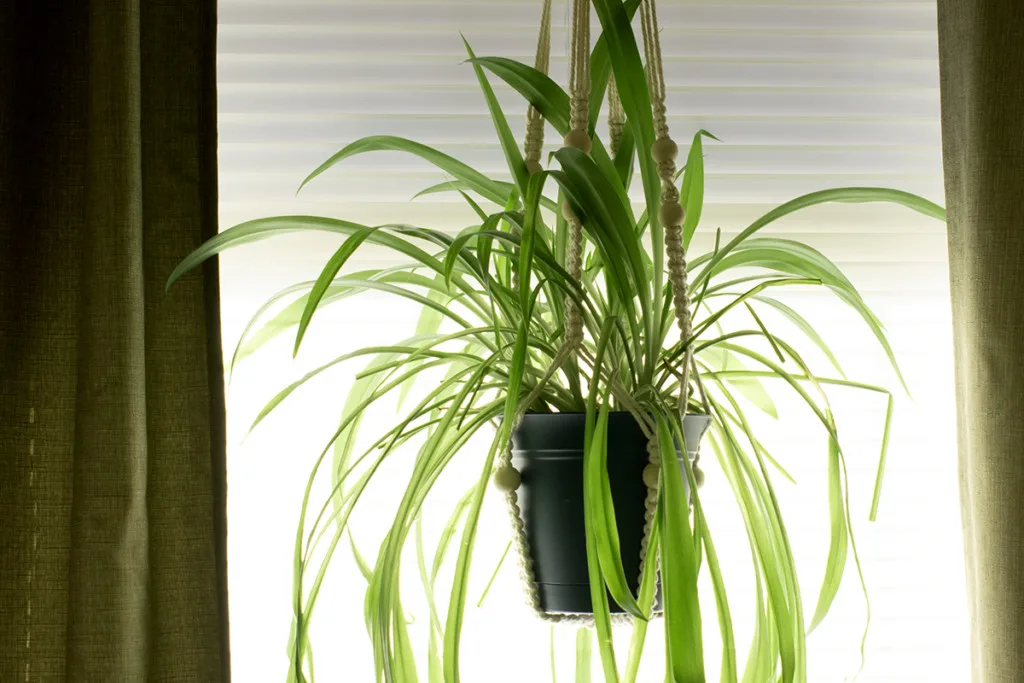
Chlorophytum comosum is among the most popular and hardest to kill houseplants.
I love spider plants.
They’re at the top of this list simply because they’re nearly indestructible.
I kept a huge, thriving spider plant in a plastic bucket with no soil for four years. I lost track of the number of times I completely forgot about it for several weeks. Eventually, I would notice it looking kind of droopy, water it, and it would bounce right back. I ended up splitting it and putting it in actual pots with soil, and now I have four spider plants to ignore.
You know it’s a robust plant when NASA gives it the all-clear to go to space.
Spider plants are either all green or some variation of green and white striped leaves.
They do best in bright, indirect light, but will grow well in partial shade and can tolerate some direct sun. Too much direct sun and the color will fade.
Set them up with a quick-draining soil mix, and you’re good to go. They like a thorough soaking, but prefer it if they’re allowed to dry out between waterings. So, forgetful waterers, spider plants are the plants for you.
They’re also prolific little guys, often producing many ‘pups’ or baby spider plants, which can be snipped off and planted directly in soil for a new plant. Spider plants are pet-safe for both dogs and cats.
2. Snake Plant
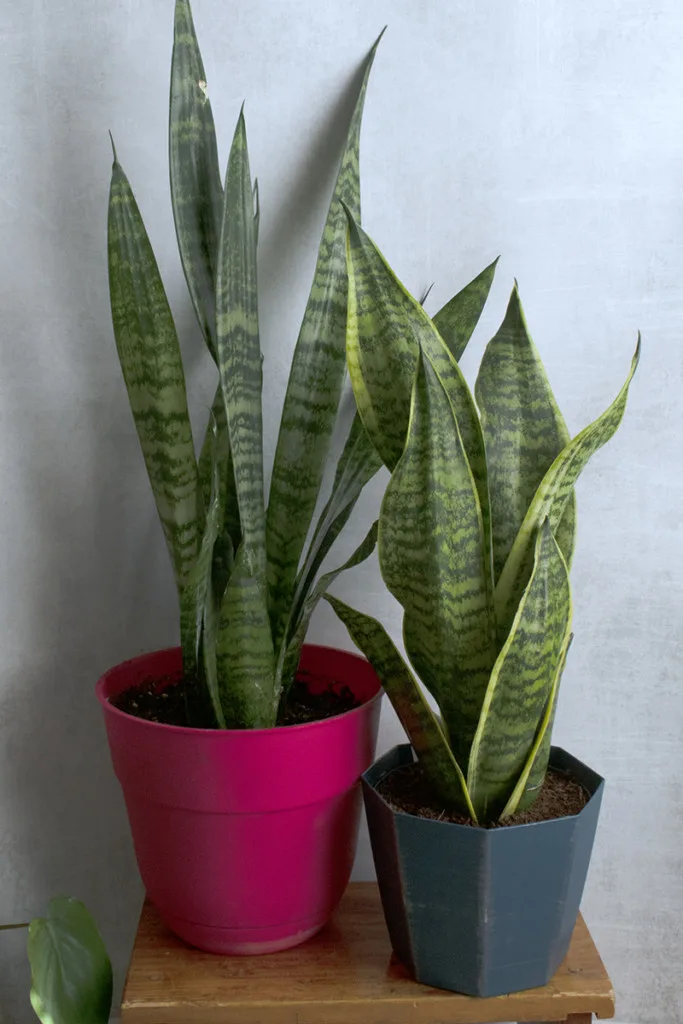
Snake plants, or Sansevieria, also charmingly known as mother-in-law’s tongue is a hardy beast of a plant in both looks and care.
They’re pretty adaptable when it comes to lighting. Like most houseplants, they don’t do well in direct sunlight and will get scorched. However, they tolerate low light pretty well.
Water them thoroughly and provide them with a quick-draining potting soil. Snake plants prefer to dry out between watering, so a little neglect works out just fine.
I love the look of sansevieria. I find them to be a refreshing change-up from the look of most houseplants.
Add to that the fact that there are numerous varieties, all with different leaf shapes, heights, and pattern variations, and you’ve got the perfect go-to housewarming present.
For an easy way to give any room a new look, grab a couple of different types and group them together.
Snake plants can easily be propagated from leaf cuttings, division or pups enabling you to quickly grow your stock. Here’s our guide to propagating your snake plants.
Snake plants are poisonous if ingested, so these aren’t great plants for pet owners. And if you do have small kiddos who like to put things in their mouths, be sure you keep this plant out of reach.
3. Pothos
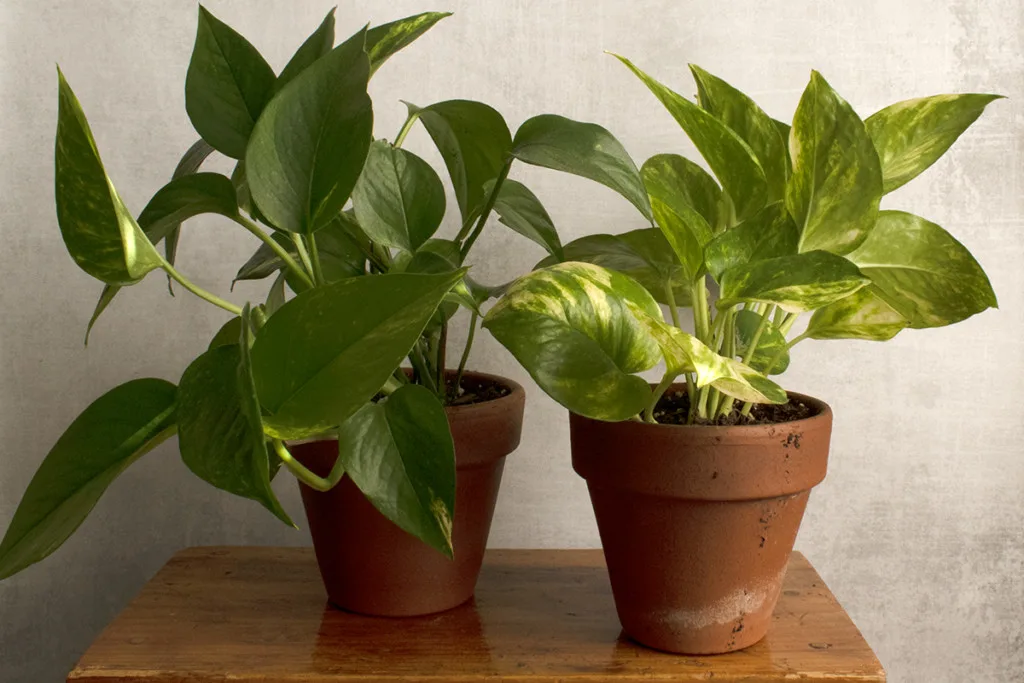
Pothos also goes by the nickname of devil’s ivy because it’s nearly impossible to kill. What a sinister name for such a gorgeous plant.
But for a tough plant, they offer some beautiful leaf colors and variations. Check out the N’Joy pothos with its striking white and green variegated leaves.
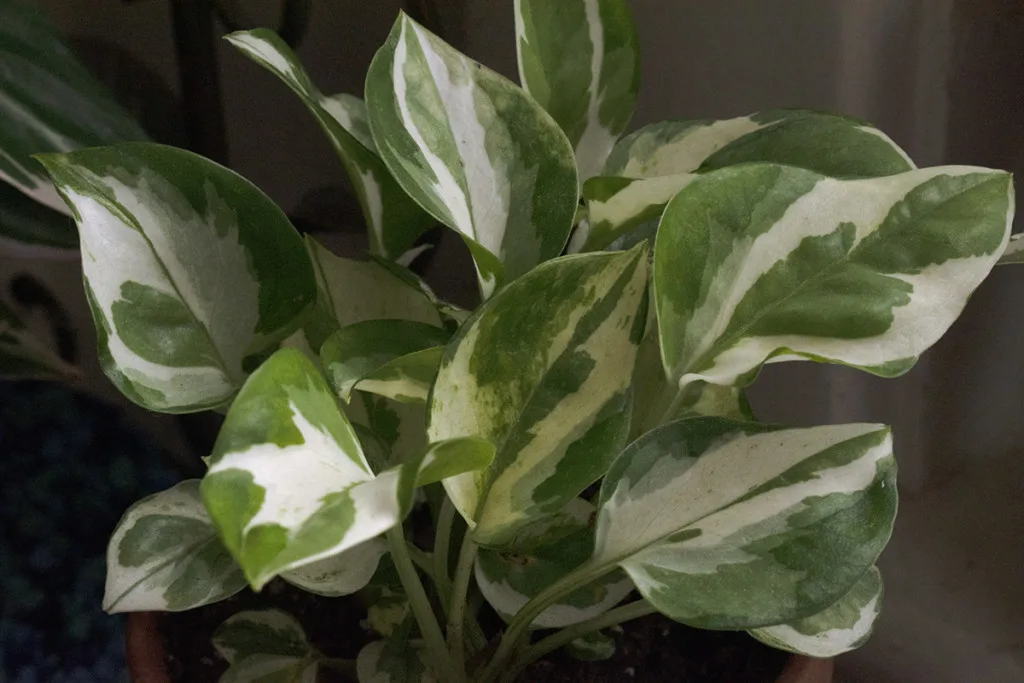
Pothos is great for someone who wants a showy plant with lots of foliage, but can also handle being forgotten about occasionally. I think these plants actually thrive on neglect.
Pothos is a climber, and you can train it to climb in pretty much any direction using a coir moss pole, a shelf, or by tying it up along a structure. They also make gorgeous hanging plants with long trailing tendrils.
Bright indirect light, low light, even a couple of hours of direct sun – the pothos can take it. Although too much bright light can cause the leaves to fade.
Pothos don’t seem to be picky about the type of soil they’re in. And again, if you forget to water it, usually a good soaking will perk it right back up.
Avoid pothos if you have furry friends at home.
4. ZZ Plant
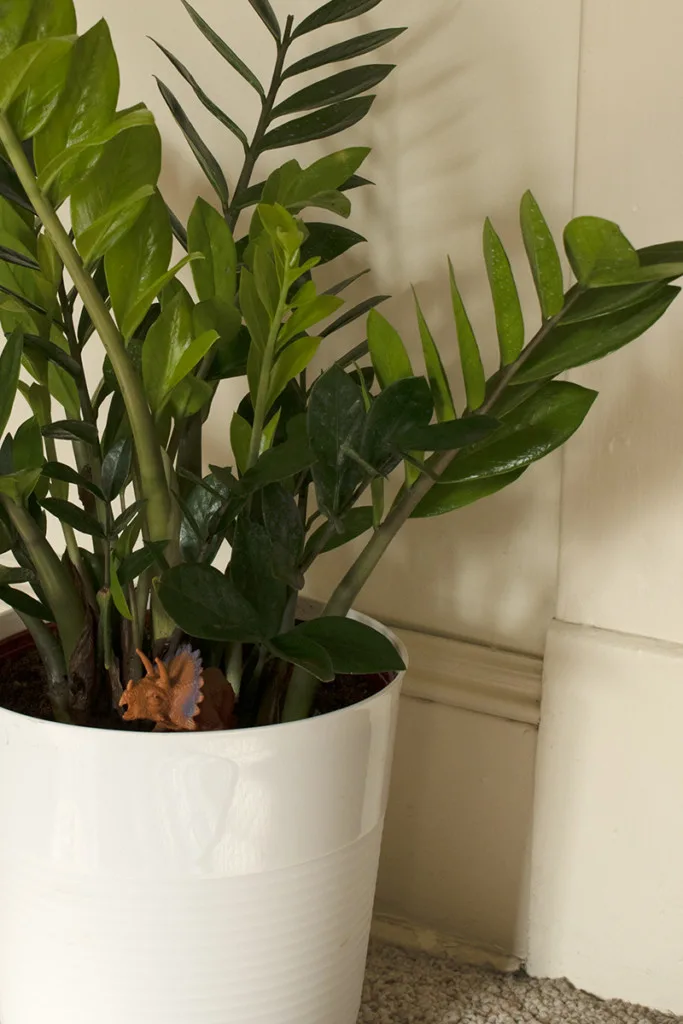
This plant makes houseplant care look easy. It will grow no matter what you do to it.
The zamioculcas zamiifolia or the ZZ plant almost takes care of itself.
These plants are spectacular for low light situations, so they make an excellent office plant too. The branches of the plant can grow up to three feet long in the right conditions. Or even in the not-so-right conditions.
My plant hangs out in a darker corner of my office, and as you can see, it’s got plenty of new growth on it.
Again, like all the plants on this list, it likes a soil that drains quickly. You can water this more frequently or forget about it, and it will be fine in either case.
Most plants sitting in wet soil for too long will develop root rot, so forgetting to water them is better than overwatering.
The ZZ plant is truly a forgiving houseplant. If you’re looking for a hardy plant that is on the larger side, get yourself a ZZ.
The ZZ plant is not a pet-friendly plant.
5. Dracaena Compacta
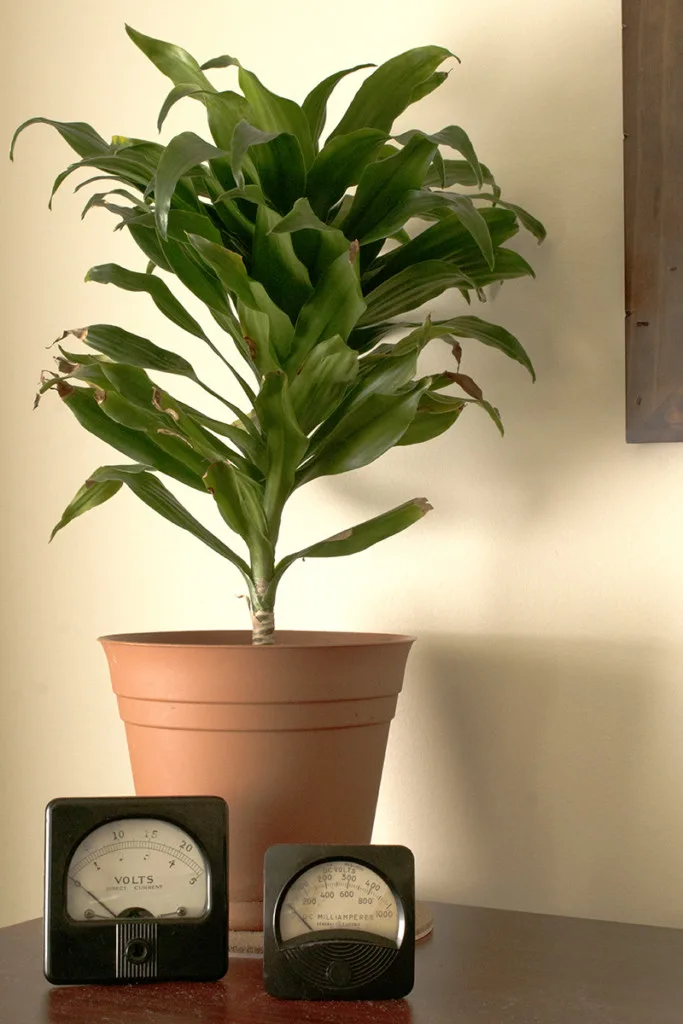
Dracaena compacta, or the dracaena Janet Craig, is the more compact version of the dracaena deremensis.
Meet poor Janet. I don’t know how many times I’ve nearly killed her by completely forgetting she even existed.
For a long time, this plant hung out on an east-facing windowsill and would get hidden by the drapes. I would eventually find it shriveled and looking pathetic; the soil so dry it was pulling away from the sides of the pot. I would give it a good soaking, trim off the dead leaves and it would bounce back. And, as you can see, it’s still going strong—good ol’ Janet.
Dracaenas typically are slow growers, so don’t expect to see a lot going on with this plant even if you do take good care of it. But it’s a nice option if you want a more tropical looking plant and as I’ve already stated, it’s definitely tough.
The leaves will scorch if it’s in direct sunlight, but they do pretty well in low light. Consider Janet if you’re looking for a new coworker in the office.
Give the plant a thorough soaking and then let it dry out before watering it again. You know, on purpose or because you forgot about it.
This is another plant that’s harmful to pets, so use your judgment if you have a furry friend who likes to nibble.
6. Aloe Vera
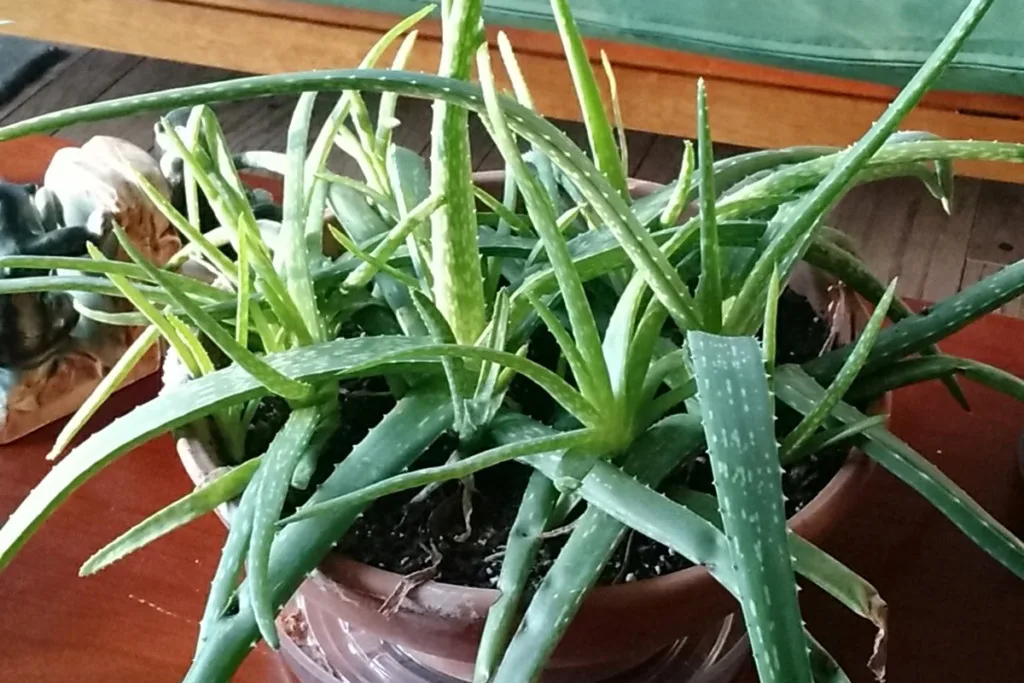
Aloe vera is another excellent set it and forget it plant. And it’s a plant with numerous health benefits, so it’s worth having one around the house.
You can use aloe vera gel to treat sunburn. Check out our article about how to harvest the aloe vera gel.
Aloe vera is a succulent and is quite happy to go about growing and making new pups with very little extra care on your part.
This plant does prefer a slightly sandier well-draining soil mix. Any succulent specific potting mix will do just fine.
Oddly enough, these plants can get sunburn themselves if they’re left in direct light for too long. But they’re one of the few plants which can tolerate a couple of hours of direct sunlight.
If your aloe starts to turn a brownish-green, you’ll need to find a less sunny spot for it. But anywhere with a good amount of bright indirect light will keep this plant happy.
Aloe will let you know when it needs to be watered by getting particularly droopy. Like every other plant on the list, give it a good watering and let it drain. Usually, an aloe plant should be watered every couple of weeks, but in the winter months, you can get away with once a month.
Aloe is not safe for cats and dogs.
7. Wandering Dude or Inch Plant
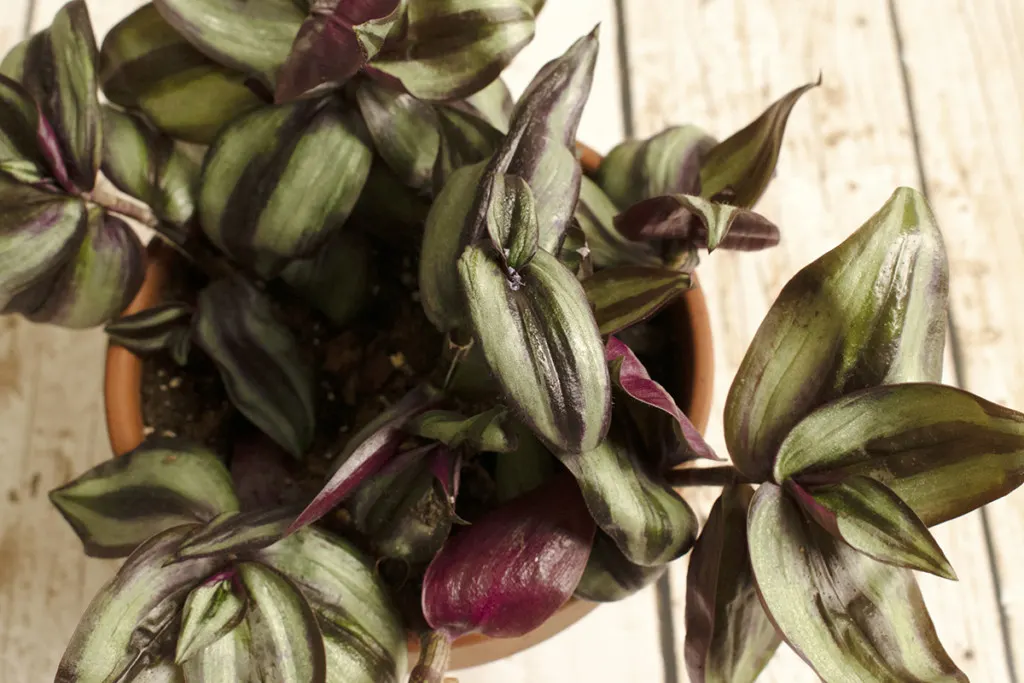
Tradescantia zebrina is a personal favorite. I love their color combination of silvery green and deep maroon.
The Wandering Dude goes by several other names, including spiderwort, zebra plant, and inch plant. And it’s one of the easiest plants to bring back from the dead.
Even if you do manage to do serious damage to this plant, they’re incredibly easy to propagate and fill out quickly. Check out our full care guide for how to propagate tradescantia.
You can keep these in a pot or as a hanging plant. But if you’re not looking to invest a lot of time in care, then it will get pretty leggy, so you may wish to start with it in a hanging pot.
They’ll do well in both bright light and low light situations. However, the markings will change depending on how much light it’s getting.
You’d be surprised at how long it can go without being watered before it starts to look pitiful.
Tradescantia is another plant that has a lot of gorgeous color variations, making it an excellent choice for showy foliage without a lot of work.
Wandering Dude is not a pet-friendly plant.
8. Air Plant
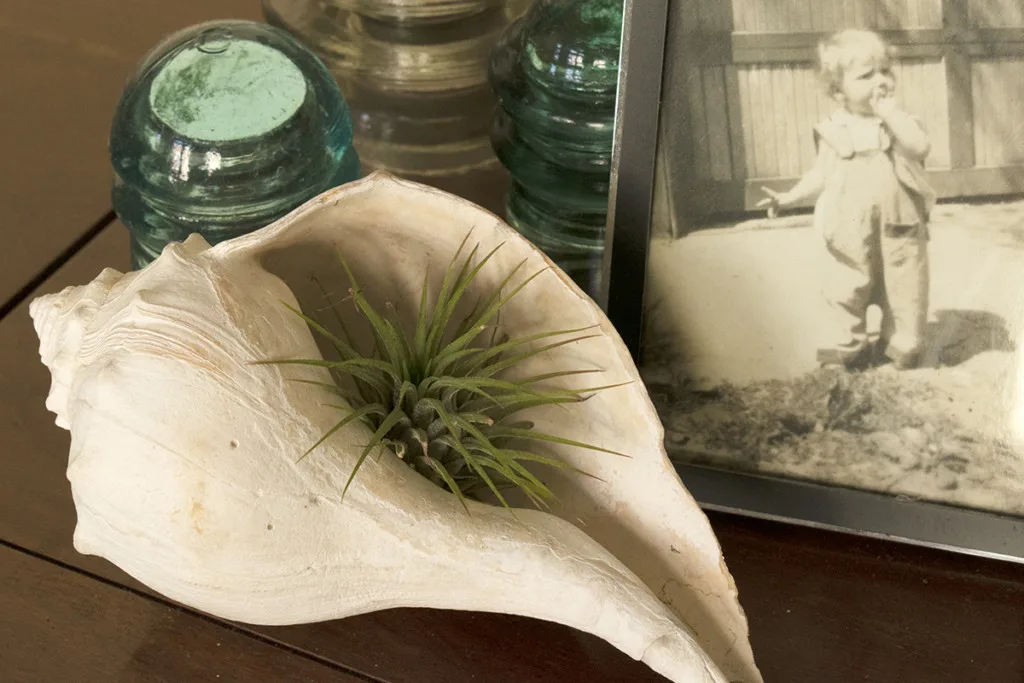
This little guy right here is a pretty cool plant. The tillandsia or air plant is the ultimate hard to kill plant. Even when it’s healthy, it kind of looks like someone forgot about it for ages.
But tillandsias are a lot of fun because you don’t need to plant them in soil. You can pop them just about anywhere, and they look nice.
And if any plant thrives on neglect, it’s the air plant. You can forget about it for weeks, and all you need to do is pop it upside down in some water for about a half-hour, and it will perk back up.
Just be sure it dries out thoroughly once it’s had a bath. Ideally, you should give it a spritz of water every week or so, but it’s on our hard to kill list for a reason.
They like a lot of bright indirect light and do well in humid environments. If you’ve got a sunny bathroom, you’re all set. The steam from your shower will keep an air plant pretty happy, meaning there is very little else you need to do.
These are fun plants to give as gifts because they come in some pretty wild forms, and as I already mentioned, they can go anywhere.
I have a few conch shells from a vacation to Chincoteague Island, and all of them have a tillandsia tucked inside them.
And adding to this plant’s numerous charms, it’s pet safe.
And there you have it plenty of plants can tolerate a forgetful owner.
You don’t have to have a green thumb to keep these plants alive.
If you do take the time to give them the proper care, they’ll grow and provide you with all the benefits that go along with indoor plants. But at the end of the day, there’s no shame in having to pitch a plant that you’ve neglected for too long.
Give a few of these hardy houseplants a try, and you’ll do just fine.

Get the famous Rural Sprout newsletter delivered to your inbox.
Including Sunday musings from our editor, Tracey, as well as “What’s Up Wednesday” our roundup of what’s in season and new article updates and alerts.


